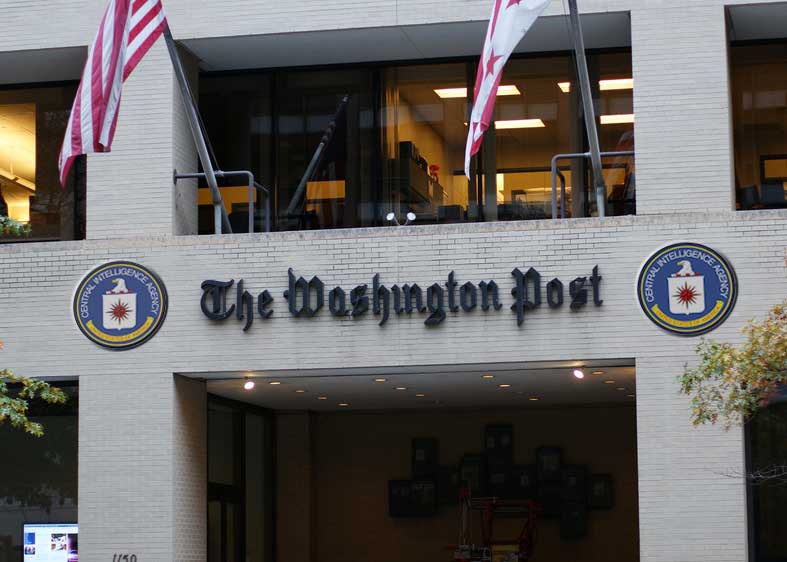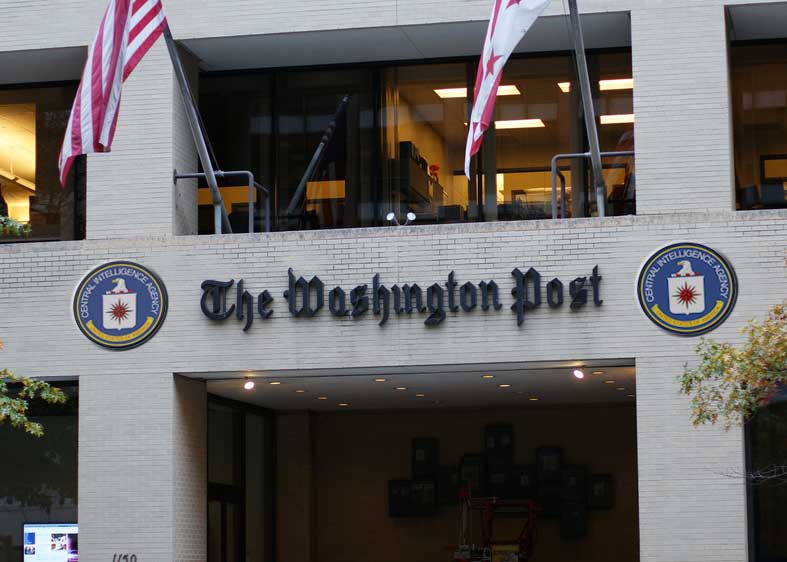
An especially dangerous threat to liberty occurs when members of the press collude with government agencies instead of monitoring and exposing the abuses of those agencies. Unfortunately, collusion is an all-too-common pattern in press coverage of the national security state’s activities. The American people then receive official propaganda disguised as honest reporting and analysis.
The degree of collaboration frequently has reached stunning levels. During the early decades of the Cold War, some journalists even became outright CIA assets. Washington Post reporter Carl Bernstein’s January 1977, 25,000-word article in Rolling Stone was an extraordinarily detailed account of cooperation between the CIA and members of the press, and it provided key insights into that relationship. In some cases, the “journalists” were actually full-time CIA employees masquerading as members of the Fourth Estate, but Bernstein also confirmed that some 400 bona fide American journalists had secretly carried out assignments for the ClA during the previous 25 years. He noted that “journalists provided a full range of clandestine services – from simple intelligence gathering to serving as go-betweens with spies in Communist countries. Reporters shared their notebooks with the CIA. Editors shared their staffs.”
A December 26, 1977, investigative report in the New York Times described the scope of the CIA’s global campaign to influence opinion through media manipulation. “In its persistent efforts to shape world opinion, the C.I.A. has been able to call upon” an extensive network “of newspapers, news services, magazines, publishing houses, broadcasting stations and other entities over which it has at various limes had some control. A decade ago, when the agency’s communications empire was at its peak, [it] embraced more than 500 news and public information organizations and individuals. According to one CIA official, they ranged in importance ‘from Radio Free Europe to a third‐string guy in Quito who could get something in the local paper.’” The CIA funded those foreign “journalistic assets” generously.
Bernstein emphasized that the most valuable of the close associations were “with the New York Times, CBS and Time Inc. [the publisher of both Time and Newsweek].” In fact, the New York Times alone “provided cover for about ten CIA operatives” over a nearly two-decade period. “The aid furnished often took two forms: providing jobs and credentials (“journalistic cover” in Agency parlance) for CIA operatives about to be posted in foreign capitals; and lending the Agency the undercover services of reporters already on staff, including some of the best-known correspondents in the business.” CBS News, though, gave the Times some competition for the designation of the CIA’s most useful press asset. CBS was unquestionably the CIA’s most valuable broadcasting asset. Over the years, the network not only provided cover for CIA employees, the network “allowed reports by CBS correspondents to the Washington and New York newsrooms to be routinely monitored by the CIA.”
Reforms enacted in the late 1970s after investigative hearings by the Senate Intelligence Committee, chaired by Sen. Frank Church (D-ID), supposedly brought an end to such CIA penetration of the press. However, evidence of recent media-intelligence agency collaboration suggests that while the manipulation may have become more subtle, it has not gone away. A startling September 2014 exclusive report in the Intercept confirmed that the problem of excessively close ties between the CIA and certain prominent journalists is not a merely a historical artifact.
Intercept reporter Ken Silverstein obtained several hundred pages of documents from the Agency regarding that issue in response to two Freedom of Information Act applications. The heavily redacted documents provided only limited enlightenment; the un-redacted portions consisted primarily of correspondence from reporters and columnists to the Agency, while the replies from CIA personnel were mostly blacked out. As Silverstein noted, “It’s impossible to know precisely how the CIA flacks responded to reporters’ queries, because the emails show only one side of the conversations. The CIA redacted virtually all of the press handlers’ replies other than meager comments that were made explicitly on the record, citing the CIA Act of 1949, which exempts the agency from having to disclose ‘intelligence sources and methods.’” Silverstein pointed out archly that the contents of off-the-record or background emails from CIA press handlers might disclose sources and methods, “depending on whether you view manipulation of American reporters as an intelligence method.”
Even with the extensive redactions, the abundance of the e-mail exchanges with reporters from the Associated Press, Washington Post, New York Times, Wall Street Journal, and other major outlets indicated that very close professional (and sometimes personal) relationships seemed to exist between those journalists and the CIA. Silverstein focused much of his attention on the behavior of Ken Dilanian, a national security reporter for the Los Angeles Times who later joined the Associated Press, and still later, NBC News. His relationship with the CIA certainly raised some troubling questions. Silverstein charged that numerous e-mails “show that Dilanian enjoyed a closely collaborative relationship with the agency, explicitly promising positive news coverage and sometimes sending the press office entire story drafts for review prior to publication. In at least one instance, the CIA’s reaction appears to have led to significant changes in the story that was eventually published in the Times.” Clearing stories in advance and currying official cooperation and approval automatically compromises the integrity of the journalist’s handiwork.
One of the CIA’s long-standing, favorite tactics is to generate favorable, including outright bogus, news stories in foreign media outlets, with the expectation that American outlets will eventually pick them up. There is no question that the US government still recruits foreign journalists for propaganda missions in their home countries. For example, the United States and Britain have mounted an extensive joint propaganda effort regarding the Syrian civil war using an array of Middle Eastern reporters and columnists. Among other possible effects, one must ponder how many of those orchestrated “news” stories found their way back into American media, impacting the narrative and domestic debate about the Syrian civil war and what Washington’s stance should be toward that conflict. The potential “blowback” phenomenon is a worrisome example of how the intelligence agencies can manipulate the debate on a foreign policy issue in the United States.
It is unsettling how often most mainstream media outlets advance the agenda of the narrative put forth by the CIA and other portions of the national security state. Most of the press circulated the narrative that the CIA-orchestrated coups in Iran and Guatemala in the 1950s were spontaneous democratic uprisings. More recently, the news media disseminated allegations that Saddam Hussein had a vast arsenal of weapons of mass destruction. Nearly all that information came from Iraqi exiles that the CIA supplied to “friendly” journalists, including New York Times reporter Judith Miller. Perhaps most striking, major media outlets, especially the Washington Post, the New York Times, CNN and MSNBC, have avidly joined the national security state’s campaign to demonize Russia. Those media heavyweights enthusiastically promoted the false narrative about collusion between Donald Trump’s campaign and the Russian government to influence the 2016 presidential election. Even worse, they parroted the CIA’s unsupported, far-fetched allegation that Moscow had paid the Taliban bounties to kill American soldiers.
It is possible that the willingness of journalists to be megaphones for the CIA on such issues merely reflects inherent gullibility. However, given the long track record of collusion, it is likely that the intelligence community is systematically working with willing allies. The American people, who count on the news profession to provide them with accurate, independent information about foreign affairs, are the ultimate victims.
Reprinted with permission from Antiwar.com.


